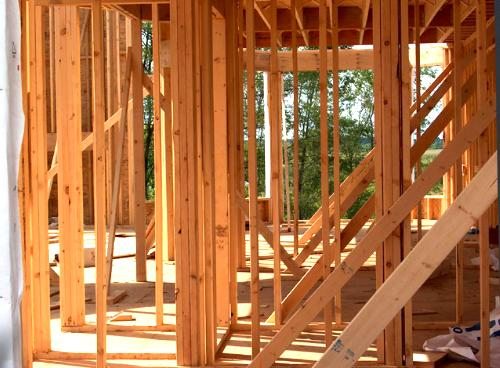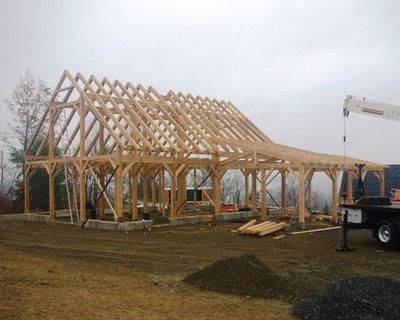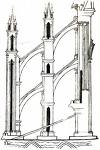Quiz 3: Structures

- 1.
Read the article Framed Structure and answer questions 1 thru 6. A framed structure does not depend on ________ to resist deformation.
- A.
Skeleton
- B.
The post and lintel system
- C.
The rigidity of the materials
- D.
Floors
Correct Answer
D. Floors -
- 2.
The balloon frame was preferred over the heavy timber frame because of its __________.
- A.
strength
- B.
Weight
- C.
Easy assembly
- D.
Sophisticated joinery
Correct Answer
C. Easy assembly -
- 3.
Sheathing protects as well as ___________.
- A.
weakens a framed structure
- B.
Strengthens
- C.
widens
- D.
Narrows
Correct Answer
B. Strengthens -
- 4.
This picture is an example of a _________________.
- A.
Masonry skeleton
- B.
Light wood frame
- C.
Heavy-timber frame
Correct Answer
C. Heavy-timber frame -
- 5.
The simplest framing is the _________ frame.
- A.
Heavy timber
- B.
Balloon
- C.
Steel
- D.
Light
Correct Answer
C. Steel -
- 6.
Steel frames can ______ longer distances than wood frames.
Correct Answer
span - 7.
A _______ is a structure comprising one or more triangular units constructed with straight members whose ends are connected at joints referred to as nodes.
- A.
Truss
- B.
Beam
- C.
Cantilever
- D.
Gable
Correct Answer
A. Truss -
- 8.
This picture is an example of __________.
- A.
Flying buttressing
- B.
Buttressing
- C.
Arch
- D.
Space frame
Correct Answer
A. Flying buttressing -
- 9.
____________ walls support only their own weight.
- A.
Non-bearing
- B.
Load-bearing
- C.
Retaining
- D.
Exterior
Correct Answer
A. Non-bearing -
- 10.
__________________ is built against wall to support or reinforce.
- A.
Setbacks
- B.
Arches
- C.
Buttressing
- D.
Posts
Correct Answer
C. Buttressing -
- 11.
Many great buildings built in early ages are still in existence and in use. Among them are the Pantheon and the Colosseum in Rome, Hagia Sophia in Instanbul, the Gothic churches of France and England, and the Renaissance cathedrals, with the great domes, like the Duomo in Florence and St. Peter's in Rome. They are massive structures with thick stones walls that counteract the thrust of their great weight. Thrust is the pressure exerted by each part of a structure on its parts. ACCORDING TO THE INFORMATION OF THIS PARAGRAPH, MASSIVE STRUCTURES FROM THE PAST ARE STILL IN EXISTENCE BECAUSE __________
- A.
Pressure was counteracted by the thick stones of these structures.
- B.
Pressure was exerted by each part of the structure.
- C.
Pressure was counteracted by the thrust of the stone walls.
- D.
Pressure was exerted by the thrust.
Correct Answer
A. Pressure was counteracted by the thick stones of these structures. -
- 12.
The Romans made extensive use of the arch to distribute thrust more evenly, thus making larger openings posible. Architects and engineers before the Romans had used the post-and-lintel construction for the most part, with two vertical columns supporting a horizontal beam. If the beam is too long, or if it has to support too much weight, it is subject to shear. Shear is the tendency to fracture or break along the lines of the stress. Stress is the force or pressure that tends to strain or deform a structure or its various parts. ACCORDING TO THIS PARAGRAPH WE CAN DEDUCE THAT BREAKAGE AND FRACTURING OF BEAMS CAN BE CAUSED BY THE ______
- A.
Stress and the shear of the beams and columns.
- B.
Length of the beam and the weight it supports.
- C.
Tendency of the beam to deform under weight.
- D.
The breakage of columns.
Correct Answer
B. Length of the beam and the weight it supports. -
Quiz Review Timeline +
Our quizzes are rigorously reviewed, monitored and continuously updated by our expert board to maintain accuracy, relevance, and timeliness.
-
Current Version
-
Oct 14, 2013Quiz Edited by
ProProfs Editorial Team -
Mar 10, 2010Quiz Created by
Mnajul
 Back to top
Back to top





